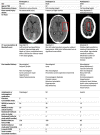Using home monitoring technology to study the effects of traumatic brain injury in older multimorbid adults
- PMID: 37537851
- PMCID: PMC10502679
- DOI: 10.1002/acn3.51849
Using home monitoring technology to study the effects of traumatic brain injury in older multimorbid adults
Abstract
Internet of things (IOT) based in-home monitoring systems can passively collect high temporal resolution data in the community, offering valuable insight into the impact of health conditions on patients' day-to-day lives. We used this technology to monitor activity and sleep patterns in older adults recently discharged after traumatic brain injury (TBI). The demographics of TBI are changing, and it is now a leading cause of hospitalisation in older adults. However, research in this population is minimal. We present three cases, showcasing the potential of in-home monitoring systems in understanding and managing early recovery in older adults following TBI.
© 2023 The Authors. Annals of Clinical and Translational Neurology published by Wiley Periodicals LLC on behalf of American Neurological Association.
Conflict of interest statement
We have no competing interests to declare.
Figures



References
MeSH terms
Grants and funding
LinkOut - more resources
Full Text Sources
Medical

